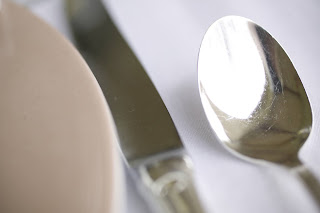Best Dressed Table: Utensils
As
an etiquette expert, I am frequently asked about the multitude of utensils and
which glass is used for what. Some table settings
can be a bit daunting, but they shouldn’t be. There’s rarely an excuse to
set more than three of any one type of utensil on the table at any time.
Plus, for very formal meals, the utensils are set in the order of the
courses. So, it is easy to choose the correct one. Just choose the
utensil that makes the most sense from the outside.
Say
your current course is a soup. Pick up
the spoon from the outermost left of your place setting.
What
follows is the basics of what you might find on a nicely set table.
Utensils
There
are three basic utensils: fork, knife, and spoon. If there is ever a
question of which one to use, just
ask yourself if you need to stab it, cut it, or scoop it.
Fork, Spoon, & Knife
Forks
Dinner
Fork:
all-purpose, used for the main course, salad, and fish.
- May be used for removing butter from your bread plate for food on the dinner plate.
Salad
Fork:
smaller than the dinner fork, and many times has one tine that is broader than
the others.
- May
be used as dessert fork
or fish fork.
Oyster
Fork:
small with short tines.
- Used to eat seafood on the half shell or seafood cocktails.
Fish
Fork:
about the same size as a salad fork with broader tines.
Fruit
Fork:
small, narrow fork used with a small knife—not used much anymore.
Spoons
Teaspoon:
multipurpose, used for cereal, dessert, coffee, tea, and soup in cups.
Soup
Spoons: traditionally, the round bowl is used for clear
soups and the oval for cream or hearty soups.
- Most people today use these for either soup.
- Traditionally, clear soups were served in cups or deep-sided bowls, while hearty or cream were served in rimmed soup plates.
Dessert
Spoon: larger than a teaspoon, but most people use the
teaspoon.
Demitasse
Spoon: small spoon used with after-dinner coffee served in
small demitasse cups with saucers.
Grapefruit
Spoon: small, sharp spoon, pointed bowl, and usually a serrated
tip.
Iced-Tea
Spoon: long-handled, used for stirring iced tea.
- These are quite common in some parts of the country.
Knives
The
knife is the oldest utensil besides our fingers.
Dinner
Knife: the most common, also called the place knife.
- These are used for everything on your plate.
Steak
Knife: sharp-bladed with a serrated edge, used for cutting
dense cuts of meat.
Fish
Knife: wide blade used to cut around bones easier.
Butter
Knife: small, broad blade used to take a portion of butter
from the butter plate to transfer to the edge of the bread plate or dinner
plate.
- Butter the bread with your own butter spreader or dinner knife.
Butter
Spreader: small, blunt, used to spread butter, jam, or anything else
on bread.
- It may be used as a cheese spreader during the cheese course.
Fruit
Knife: small, sharp, used for cutting fruit at a formal
meal.
- Quarter the fruit, remove the core and seeds and eat fruit with fingers.
- If there is a fruit fork use the two utensils to cut and eat one bite at a time.
And...
- A luncheon service is slightly smaller than a dinner service and may be use for dinner.
- Stainless steel is fine for every day and very versatile.
- Always consider weight and how it feels in your hands.
- Sterling silver is beautiful, can be used for any meal, including formal meals, and nothing looks better on the table.
Excerpt From:
Entertaining Skills 101: The Etiquette of Entertaining Our Guests by Rebecca Black

Comments
Post a Comment